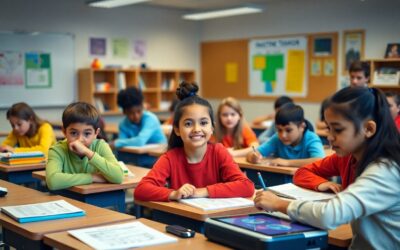Many educators strive to meet the diverse needs of their students, yet creating personalised education plans can seem overwhelming. This guide will help you navigate the vital steps to craft tailored plans that effectively address each student’s unique strengths and challenges. By focusing on individual learning styles, goals, and support mechanisms, you will empower your students to thrive academically and personally. With the right strategies, you can foster an inclusive learning environment that champions every student’s potential.
Understanding Individual Student Needs
While creating personalized education plans, it’s necessary to recognize that each student has unique needs that influence their learning journey. Understanding these differences allows you to tailor your approach and ensure that educational strategies facilitate growth and engagement. By identifying individual strengths and challenges, you can develop meaningful connections that lead to improved academic outcomes and overall student well-being.
Identifying Learning Styles
You can enhance your personalized education plans by identifying the distinct learning styles of your students. Whether they thrive through visual aids, auditory experiences, or hands-on activities, recognizing these preferences allows you to implement strategies that resonate with each learner. This tailored approach fosters a more engaging environment, making it easier for students to absorb and retain information effectively.
Assessing Skill Levels and Gaps
With a thorough assessment of skill levels and existing gaps, you gain insight into what your students need to succeed. Understanding their current competencies supports the creation of targeted interventions and learning opportunities that help them progress. This assessment process ensures that your educational plans are both relevant and effective in promoting academic achievement.
Individual assessments can take many forms, including standardized tests, formative assessments, and informal observations. By gathering data on each student’s performance, you can pinpoint specific areas where they excel and where they need support. This holistic approach allows you to create step-by-step learning objectives that bridge gaps, ensuring that students build the necessary foundation to advance in their studies. Tailoring your plans in this way leads to improved outcomes and a more tailored educational experience.
Key Factors in Personalized Education Plans
One of the most significant components of a personalized education plan is understanding the diverse needs of each student. To create an effective plan, consider the following key factors:
- Student strengths and weaknesses
- Learning styles and preferences
- Academic and personal goals
- Available resources and support systems
After evaluating these factors, you can develop a tailored approach enhancing each student’s learning experience.
Setting Achievable Goals
Now, it’s necessary to set achievable goals for your students. These goals should be specific, measurable, and realistic, focusing on short-term and long-term achievements. By breaking down objectives into manageable steps, you empower your students to track their progress and stay motivated.
Choosing Appropriate Resources
Plans for personalized education can be significantly enhanced by selecting the right resources. You’ll want to consider both digital tools and traditional materials that align with each student’s unique learning style. Look for resources that engage their interests and support their educational goals.
Another important aspect of choosing appropriate resources involves ensuring accessibility and relevance. Assess the needs of your students and seek resources that promote inclusivity, offering varied formats like visual aids, audiobooks, or interactive software. Tailoring resource selection to fit individual learning preferences not only boosts engagement but also reinforces the educational plan’s effectiveness.
How to Develop an Effective Plan
It’s necessary to design a personalized education plan that addresses the unique learning styles and needs of each student. Start by gathering comprehensive information on their academic performance, interests, strengths, and areas for improvement. Collaborate with educators and use various assessment tools to ensure a well-rounded understanding of the student. This information will allow you to tailor the plan effectively, setting realistic goals and incorporating diverse teaching strategies that engage and motivate the student to achieve their full potential.
Collaboration with Students and Parents
Little involvement from students and parents can significantly enhance the effectiveness of an education plan. Engaging them in discussions about their goals, preferences, and concerns helps ensure the plan reflects the student’s interests and aspirations. By fostering open communication, you create a supportive environment that encourages active participation, making the learning process more meaningful and personalized for the student.
Regular Monitoring and Adjustments
Any successful education plan requires ongoing assessment and flexibility. You must regularly monitor the student’s progress and evaluate the effectiveness of the teaching strategies implemented. This allows you to identify which aspects of the plan are working and which ones may need adjustments. Being proactive encourages continuous improvement and helps maintain the student’s motivation and engagement.
To ensure your education plan remains relevant and effective, establish a routine for reviewing the student’s progress and adapting the plan as necessary. Gather feedback from the student, parents, and educators to gain diverse perspectives on the learning experience. By being attentive to shifts in the student’s performance, you can implement timely changes that enhance learning outcomes and support their growth.

Tips for Successful Implementation
Not only is successful implementation important for the effectiveness of personalized education plans, but it also requires careful attention to various factors. Consider these tips:
- Communicate clearly with students and their families.
- Regularly assess and adjust the plan based on student progress.
- Foster collaboration among teachers and educators.
- Provide training and resources for staff.
This collaborative effort helps create a dynamic learning environment where all students can thrive.
Creating a Supportive Learning Environment
The foundation of personalized education plans is a supportive learning environment. You should prioritize building rapport with your students to create trust and open communication. This will enable you to understand their unique needs better and encourage them to express their learning preferences freely.
Utilizing Technology and Tools
If you want to enhance personalized education plans, integrating technology and various educational tools is crucial. Evaluating educational software and apps can help you identify resources that cater to individual learning styles and abilities.
Successful implementation of technology allows for tailored learning experiences through adaptive learning platforms and online resources. These tools can provide instant feedback and allow you to track student progress efficiently. Additionally, gamification and interactive tools can maintain engagement while promoting mastery of the material, ensuring every student receives a custom-fit educational experience.
Overcoming Common Challenges
Your personalized education plans may face several challenges, such as resistance to change and maintaining consistency among educators. Addressing these issues is important for the successful implementation of individualized learning strategies. By proactively identifying obstacles and creating strategies to address them, you can foster a more effective learning environment that adapts to every student’s unique needs.
Addressing Resistance to Change
To effectively address resistance to change, it is important to involve all stakeholders early in the process. By communicating the benefits of personalized education and encouraging collaboration, you can help reduce anxiety and foster a sense of ownership among educators. Providing training and resources also empowers your team to embrace new methodologies and best practices.
Ensuring Consistency Across Educators
With effective communication and collaboration, you can ensure consistency across educators when implementing personalized education plans. Establishing shared goals, strategies, and assessments will help create a united approach, emphasizing the importance of teamwork in meeting student needs.
Overcoming inconsistency among educators requires regular meetings and open dialogue. You should encourage teachers to share experiences, challenges, and successful tactics for implementing their personalized education plans. Developing common assessments and feedback loops can further ensure that all educators are on the same page, ultimately providing a cohesive learning experience for your students. By promoting continuous collaboration and reflection, you can foster an environment where personalized education truly thrives.
The Role of Feedback in Personalization
Now, feedback serves as the backbone of personalized education plans, enabling you to adjust your strategies according to the unique needs of each student. By actively seeking and incorporating input, you can ensure that the educational experience is tailored, effective, and engaging. Not only does feedback help you identify areas for improvement, but it also fosters a collaborative environment where students feel valued and understood.
Gathering Input from Students
Students provide valuable insights about their learning preferences and challenges, which can significantly inform your personalization efforts. By creating opportunities for open dialogue—such as surveys, one-on-one meetings, or suggestion boxes—you can gain a better understanding of their individual needs. This approach not only helps you refine your teaching methods, but also empowers students to take an active role in their own learning journeys.
Incorporating Insights for Improvement
Gathering feedback allows you to pinpoint specific areas that require adjustment in your education plans. You should analyze this input diligently to identify patterns and make necessary modifications to your approaches. By integrating student suggestions and reflecting on their experiences, you enhance not just the personalization of your lessons, but the overall learning environment. This iterative process promotes continuous improvement and ensures that the educational experience remains relevant and responsive to student needs.
This ongoing cycle of feedback and adjustment is fundamental to ensuring that personal education plans resonate with each individual. By establishing a routine for collecting and analyzing student feedback, you can transform your teaching practices to cultivate a more effective learning environment. Each iteration refines your approach, directly impacting your students’ success and engagement in the learning process.
Final Words
Summing up, creating personalized education plans that cater to individual student needs involves understanding each student’s strengths, interests, and challenges. You should begin by conducting thorough assessments to identify their specific requirements. Collaborate with the student, their parents, and other educators to design a flexible plan that includes tailored learning goals and resources. Regularly review and adjust the plan based on progress and feedback to ensure it remains effective. By actively engaging in this process, you empower your students to achieve their full potential while fostering a supportive learning environment.
FAQ
Q: What are personalized education plans, and why are they important?
A: Personalized education plans (PEPs) are customized learning strategies tailored to meet the unique needs, strengths, and interests of individual students. They are important because they acknowledge that each student learns differently. By focusing on specific learning goals and methodologies, PEPs help maximize student engagement and understanding, allowing for a more effective and supportive educational experience.
Q: How do I assess individual student needs to create an effective personalized education plan?
A: To assess individual student needs, start by gathering relevant data through various methods such as student assessments, observations, and interactions with parents or guardians. Consider academic performance, learning styles, and social-emotional factors. Conducting formal assessments, such as standardized tests or diagnostic evaluations, can provide insights into specific areas where a student may need additional support. Based on this information, you can identify key objective goals and necessary resources to incorporate into the personalized education plan.
Q: What strategies can I use to implement and adapt personalized education plans in the classroom?
A: Implementing personalized education plans requires a flexible approach to teaching. Begin by integrating differentiated instruction, where you vary your teaching methods and materials based on individual student needs. Utilize technology to provide interactive and multimedia resources that can be tailored to each student. Regularly check-in with students through formative assessments to gauge their understanding and progress. Be prepared to adapt the plan based on feedback and performance, ensuring it remains relevant and effective as the student develops.




0 Comments